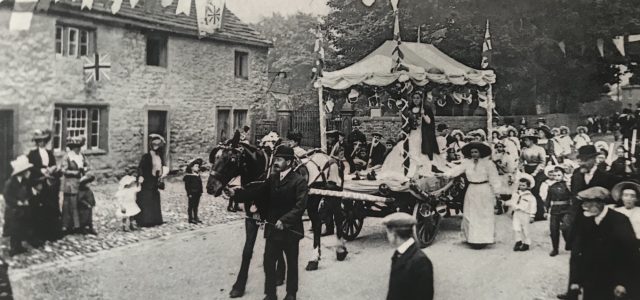
POTTED HISTORY: GISBURN
Local genealogist Dr Kate Sherry tells Sarah Varley about the fascinating history she has uncovered in researching the village of Gisburn
Dr Kate Sherry’s work as a genealogist means she tracks down records from all over the world, but her favourite projects are those that allow her to indulge her passion for the local history of Lancashire, the Ribble Valley and Pendle. Gisburn has always been of particular interest as her own children went to school there and she has worked with the schoolchildren there to help bring history to life.
“There are records of Gisburn in the Doomsday Book, where it appears as ‘Ghiseburne’, meaning ‘stream of Guy’, within the Manor of Painley,” Kate explains.
“The value of the place in terms of tax was deemed to be ‘medium’ and worth four ‘geld units’. We know that the Lord of the Manor in 1066, before the Norman invasion, was called Bernwulf, and that by 1086 at the time of the Doomsday Book, the Lord was William de Percy who will have come over from France with William the Conqueror and been awarded the land.
William de Percy’s name is associated with 176 places so it shows just how much land he was given as tenant-in-chief.
“Within the area we can still see evidence of the Normans. At Castle Haugh between Gisburn and Paythorne there is a mound where a ‘motte’ was built. Historians have suggested that this would be from one of the Percy’s quickly building a fort on top of the mound to defend against invading Scots.”
“The medieval church of St Mary’s at Gisburn has a long and interesting history. In 2015 the ‘She-Bible’ was found in a cupboard at St Mary’s by the vicar, a very rare version of the King James I bible from 1611 where chapter 3, verse 15 of the book of Ruth mistakenly reads ‘she went into the city’ instead of ‘he’.”
The church is believed to date back to at least the early 12th century, as records show a rector from Gisburn present at the dedication of Sawley Abbey in 1147.
Kate explains: “The names of the rectors at Gisburn are known from 1239 with Jordanus de Byngall, and we see increasingly familiar local names appearing on the list such as Thomas Banastre in 1423, Christopher Wilkinson in 1517 and John Lund in 1537.”
A name synonymous with Gisburn is the Lister family, who were Lords of the Manor of Gisburn for hundreds of years, from the reign of Edward II (1307-1327) when John Lister married Isabel, daughter of John of Bolton who owned the Manor of Midhope (Middop) and was Bowbearer of Bolland (Bowland).
“We know that the Listers moved to Arnoldsbiggin, near Westby Hall, within the Parish of Gisburn in 1520 when Thomas Lister married Effamia of Westby, and that the family moved to Gisburne Park, which is now a hospital, in the 1730s.”
In 1797 Thomas Lister, MP for Clitheroe, was given the title of Baron Ribblesdale of Gisburne Park. A newspaper report from 1849 recording his grandson the third Lord Ribblesdale’s 21st birthday celebrations, shows just how important the Lister family was to the area.
“A huge procession was organised, headed by Lord Ribblesdale and followed by two standards, battle axes and banners, the Temperence Brass Band and 200 people including landowners, gentry, freeholders and tenant farmers. Twenty-one shots were fired by cannon and people came from many neighbouring towns such as Settle, Clitheroe, Keighley and Burnley to watch,” says Kate.
There are also records of Oliver Cromwell staying at Gisburne Park with the Listers who were Parliamentarians, and it is rumoured that Cromwell’s horses were stabled inside St Mary’s Church and that they broke one of the stained glass windows!
“The Lister name also appears in the history of the Pendle witches,” adds Kate. “One of the women accused of witchcraft was Jennet Preston of Gisburn, who was a friend of Thomas Lister when they were growing up – so possibly not poor as the witches are often portrayed. Jennet was found guilty of the murder of Thomas Lister but it is most likely that Lister died of natural causes – but as he was dying he called out Jennet’s name. Perhaps to cover the embarrassment felt by Lister’s wife or son at his closeness to Jennet and divert attention, Jennet was accused of cursing Lister and causing his death. She was found guilty of witchcraft and hanged in 1612.”
Gisburn has long been known for its auction mart, and records show that Henry III first gave a charter in 1260 to the abbot and monks of Sawley Abbey to hold a market at Gisburn every Monday, plus a three-day fair every September. This eventually evolved into a cattle market held in the main street, attracting cattle dealers and farmers from all over the local area.
The railway came to Gisburn in 1885, as Kate explains: “It is rumoured that it was the railway company who knocked the ‘e’ off the end of Gisburn – to save time and money on painting the signs!”
kate.sherry@ancestortrail.co.uk
www.ancestortrail.co.uk

